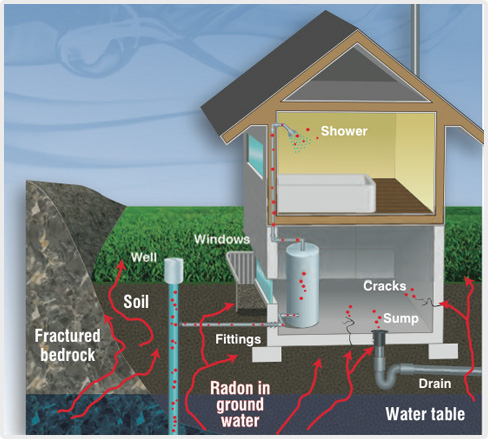Radon: Stalking The Silent Killer
If you haven’t had your home tested for radon, you might be letting a killer live at your house without even knowing it.
Radon is an odorless, colourless radioactive gas that seeps into many homes from the breakdown of uranium found in soil and rocks. The gas collects in basements and low-lying areas, and exposure can cause cancer from breathing in radioactive particles.
In fact, Health Canada estimates 3,200 Canadians die annually as a result of radon exposure. Health Canada (HC), the Environmental Protection Agency (EPA), and the World Health Organization (WHO) all say that every home or building should be tested for radon.
Despite the threat from radon, a recent survey found that 96 percent of Canadians have not tested their homes for radon gas – even though 51 percent of Canadians said they would move if they were aware that there was radon in their home.

Radon can enter a house through any opening where the house contacts the soil – from cracks and joints in foundation walls and floors, gaps around service pipes, support posts, floor drains, and sumps. Radon can also be found in ground water from private or small community wells.
Radon levels change significantly over time, rising and falling from one hour to the next. This is why Health Canada recommends that only a test lasting longer than 91 days can be used to determine if mitigation is required. Testing requires a trained professional.
You should have your home tested for radon at least every five years, or following a renovation.
The Environmental Protection Agency (EPA), World Health Organization (WHO) and Health Canada (HC) all have guidelines for radon testing and control.
Stephen of Integrated Clean Air Services is certified by the Canadian National Radon Proficiency Program (C-NRPP) to properly measure radon levels in homes. The company is also a member of the Canadian Association of Radon Scientists and Technologists (CARST).
Stephen will assess your home and decide where to place the measuring device, factoring in your existing ventilation equipment and making detailed observations regarding the environmental conditions. He can also ensure proper quality control of the testing equipment, so each test is accurate.
This is why “radon testing kits” are so unreliable. The risks associated with radon radiation exposure are too great to try and do this yourself. You owe it to yourself and to the health of your family to let Stephen run the test!
 Health Canada
Health CanadaHealth Canada recommends ALL homeowners test for indoor radon, because radon is a Level 1 carcinogen and the second-leading cause of lung cancer.
Based on a Health Canada survey, over one-third of health regions in Ontario had over 10 percent of homes with reported high radon levels.
Radon remediation is recommended if the average annual level in your home’s main living areas exceeds 200 Becquerels per cubic metre.







